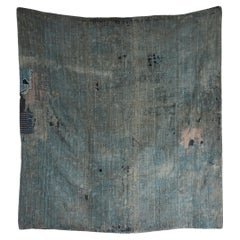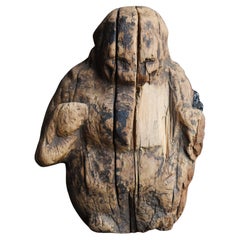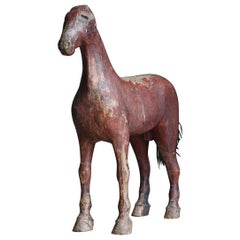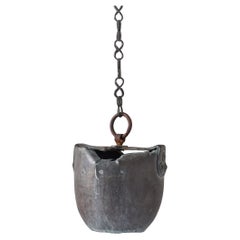Want more images or videos?
Request additional images or videos from the seller
1 of 16
Japanese Antique "BORO" 1800s-1860s / Rag Tapestry Patchwork Textile Wabisabi
Price:$1,250
$2,500List Price
About the Item
- Dimensions:Height: 66.93 in (170 cm)Width: 66.93 in (170 cm)Depth: 0.2 in (5 mm)
- Style:Edo (Of the Period)
- Materials and Techniques:
- Place of Origin:
- Period:
- Date of Manufacture:1800s-1860s
- Condition:Wear consistent with age and use.
- Seller Location:Chōsei District Nagara, JP
- Reference Number:1stDibs: LU10403245811542
About the Seller
New to 1stDibs
Joined in the past six months.
5.0
Platinum Seller
Premium sellers with a 4.7+ rating and 24-hour response times
Established in 2017
1stDibs seller since 2025
36 sales on 1stDibs
Typical response time: 1 hour
Authenticity Guarantee
In the unlikely event there’s an issue with an item’s authenticity, contact us within 1 year for a full refund. DetailsMoney-Back Guarantee
If your item is not as described, is damaged in transit, or does not arrive, contact us within 7 days for a full refund. Details24-Hour Cancellation
You have a 24-hour grace period in which to reconsider your purchase, with no questions asked.Vetted Professional Sellers
Our world-class sellers must adhere to strict standards for service and quality, maintaining the integrity of our listings.Price-Match Guarantee
If you find that a seller listed the same item for a lower price elsewhere, we’ll match it.Trusted Global Delivery
Our best-in-class carrier network provides specialized shipping options worldwide, including custom delivery.You May Also Like
Japanese Antique Rag "BORO" 1800s-1860s / Abstract Art Wabi Sabi
Located in Sammu-shi, Chiba
This is an exceptional example of a Japanese *BORO* textile, dating from the late Edo period (1800s–1860s). Carefully preserved over generations, it embodies both the resourcefulness...
Category
Antique Mid-19th Century Japanese Edo Tapestries
Materials
Fabric
$1,650
H 60.63 in W 52.76 in D 0.12 in
Antique Japanese Recycled Boro Patchwork Futon Cover
Located in Point Richmond, CA
Antique Japanese Recycled Boro Patchwork Futon Cover
This indigo-dyed patchwork boro futon cover is a physical testimony to the determination and resourcefulness of those living in ...
Category
Antique Late 19th Century Japanese Meiji Tribal Art
Materials
Cotton
1860s Antique French Silk Aubusson Tapestry
Located in Dallas, TX
73014 Antique French Silk Aubusson Tapestry, 05'00 x 07'00. French Aubusson tapestries are exquisite handwoven textiles originating from the town of Aubusson in central France. Craft...
Category
Antique Late 19th Century French Aubusson Western European Rugs
Materials
Silk
"Tutankhamun" - Textile Patchwork Tapestry c 1925
Located in Kastrup, DK
When the British Egyptologist Howard Carter discovered Tutankhamun's tomb in 1922, it created a great interest in Egyptian pharaohs.
This wall hanging...
Category
20th Century Egyptian Other Tapestries
Materials
Textile
Antique Japanese Indigo Boro textile rug w/ Sashiko stitching wabi sabi object
Located in 常陸大宮市, JP
From Tohoku area, Japan.
Antique indigo Boro textile with Sashiko stitching , probably used as Kotatsu Futon (Thick blanket for brazier table) estimate from the size & condition. 3 ...
Category
Early 20th Century Japanese Folk Art Tapestries
Materials
Cotton, Linen
$2,500
H 61.42 in W 68.51 in D 0.2 in
Turkoman Patchwork Textile, Tapestry or Armchair Upholstery
Located in Alessandria, Piemonte
Nice Turkoman patchwork textile with light colors, suitable for tapestry, headboard, armchair upholstery. They are all embroideries applied on a rein...
Category
1990s Turkmen Folk Art Tapestries
Materials
Cotton
Antique 1800 French Tapestry
Located in Los Angeles, US
A wall hanging tapestry, simply put, is a textile specifically designed and woven to portray an artistic scene with the intent of hanging it on a wall. Antique tapestries, those that...
Category
Antique 19th Century Unknown Other Tapestries
Materials
Wool, Cotton
Vintage Handmade Gujarati Tribal Saree Mirror Patchwork & Textiles Tapestry
Located in Asheville, NC
India's classical vintage Saree mirror work, historically from the Gujarati region, production started by using organic mica that looked like mirrors ac...
Category
Vintage 1950s Indian Anglo-Indian Tapestries
Materials
Cotton
$3,500
H 98 in W 79 in D 0.13 in
Japanese Indigo Antique Boro Futon Cover or Wall Panel
Located in Alessandria, Piemonte
Rare perfect antique collection Japanese Indigo Boro Futon cover : also to use.
The rare antique boros are now valued as pieces of art, therefore they are...
Category
Mid-20th Century Japanese Japonisme Textiles
Materials
Cotton
Antique Japanese Embroidery Tapestry Panel Edo Period
Located in Atlanta, GA
A large Japanese silk embroidery tapestry circa 18th century Edo period. Possibly an altar tablecloth originally, the embroidered textile pane...
Category
Antique 18th Century Japanese Edo Textiles
Materials
Silk
$3,200 Sale Price
20% Off
H 56 in W 80 in D 0.2 in
More From This Seller
View AllJapanese Antique "BORO" 1800s-1860s / Rag Tapestry Patchwork Textile Wabisabi
Located in Chōsei District Nagara, JP
This is an old Japanese BORO, dating back to the late Edo period (1800s–1860s). It is an extremely valuable textile that has been carefully preserved and passed down to the present d...
Category
Antique Mid-19th Century Japanese Edo Tapestries
Materials
Fabric
Japanese Antique Wood Carving Daikokuten 1800s-1860s / Figurine Wabisabi
Located in Chōsei District Nagara, JP
This is an old Japanese wooden carving of Daikokuten, created during the Edo period (1800s–1860s). It is carved from sugi (Japanese cedar). Having endured the passage of centuries, i...
Category
Antique Late 19th Century Japanese Edo Sculptures and Carvings
Materials
Cedar
Japanese Antique Sacred Horse "Shinme" 1800s-1860s / Primitive Wabisabi
Located in Chōsei District Nagara, JP
This is an old Japanese carved wooden horse, a highly valuable piece created in the late Edo period (early 1800s–1860s). In Japan, it is known as a "Shinme" (sacred horse), a term re...
Category
Antique Late 19th Century Japanese Edo Sculptures and Carvings
Materials
Cedar, Lacquer
Japanese Antique Copper Tub 1800s-1860s / Flower Vase Wabi Sabi
Located in Chōsei District Nagara, JP
This is an old copper tub made in Japan.
It was made during the Edo period (1800s-1860s) and used as a tool to draw water from a well.
This tool is one of the tools of daily life tha...
Category
Antique Late 19th Century Japanese Edo Vases
Materials
Copper, Iron
Japanese Antique Stone Carving Penis 1800s-1860s / Sculpture Wabi Sabi Mingei
Located in Chōsei District Nagara, JP
This is an old Japanese stone carving of a phallus, believed to have been made in the late Edo period (1800s–1860s). It is a rare and valuable a...
Category
Antique Late 19th Century Japanese Edo Sculptures and Carvings
Materials
Stone
Japanese Antique Sacred Horse Wooden Statue "Shinme" 1800s-1860s / Wabi Sabi
Located in Chōsei District Nagara, JP
This is a very rare carved wooden statue of a sacred horse that was dedicated to a Japanese shrine. It was produced during the Edo period (1800s-1860s), and the main material used is...
Category
Antique Mid-19th Century Japanese Edo Sculptures and Carvings
Materials
Cedar
Recently Viewed
View AllMore Ways To Browse
Jester Tapestry
Leger Tapestry
Needlepoint Jean Lurcat
Perrine Rousseau
Raymond Hurtu
Reeves Tapestry
Robert Debieve On Sale
Sakabukuro Japanese
Textile Wall Hanging Scandinavian
Tree Of Life Crewel
Vintage Needlepoint Bell Pull
Materia Table
Mcm Chrome Table
Mid Century Walnut 1940s Chest Of Drawers
Miniature Cloisonne
Modular Bar
Monica Backstrom
Mosque Lamp



